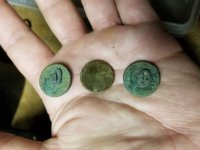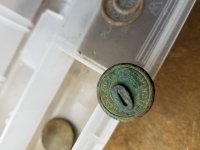NoVaRelics
Greenie
- Jun 30, 2018
- 13
- 45
- Detector(s) used
- Garrett AT MAX
- Primary Interest:
- All Treasure Hunting
Morning all. I just got a new permission and found 3 Warranted Rich Gold Plate buttons. Each button was found about 8-10 inches apart in a straight line and about 8 inches deep. This property has been in the family since early 1700's and has not been picked through. I'm looking forward to going back.
I do have a couple questions if anyone can assist:
1) cleaning- what is the best way to clean them? I've read Aluminum Jelly which I cant find anywhere, amonia, or peroxide. I've cleaned with water and tooth brush so far and they've cleaned up nicely (see attached pics)
2) Can anyone give me any history on these buttons? I've found multiple backmarks on line with similar stamps but nothing exact.
I do have a couple questions if anyone can assist:
1) cleaning- what is the best way to clean them? I've read Aluminum Jelly which I cant find anywhere, amonia, or peroxide. I've cleaned with water and tooth brush so far and they've cleaned up nicely (see attached pics)
2) Can anyone give me any history on these buttons? I've found multiple backmarks on line with similar stamps but nothing exact.
Amazon Forum Fav 👍
Attachments
Upvote
10





